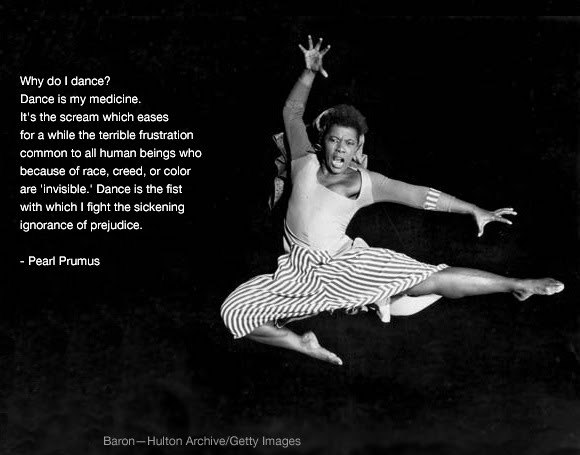
Friday, March 26, 2010
What Was Going On In My World?

Tuesday, March 2, 2010
Her Professional Lineage
 Although Pearl Primus did not start off as a dancer in her adult life, she was an athlet She went to Hunter College as a pre-med student majoring in biology. Upon graduation from college, Pearl found a strong interest in dance. She began to work with the National Youth Administration's New Dance Group in New York. In 1943, she made her first offical debut in New York in a piece called the "African Ceremonial." In order to further pursue inspirations for choreography and movement motivated by African-American culture and themes, Pearl took time within the first year of her dancing career to become apart of African-American life in the South. It was in the South that Pearl began to have an experience and connection with everyday movement in the life of southern African-Americans. In addition to being enriched in black southern culture and life, Pearl trained with modern dancers like Martha Graham, Charles Wiedmann, Doris Humprhey, and Hanya Holm.
Although Pearl Primus did not start off as a dancer in her adult life, she was an athlet She went to Hunter College as a pre-med student majoring in biology. Upon graduation from college, Pearl found a strong interest in dance. She began to work with the National Youth Administration's New Dance Group in New York. In 1943, she made her first offical debut in New York in a piece called the "African Ceremonial." In order to further pursue inspirations for choreography and movement motivated by African-American culture and themes, Pearl took time within the first year of her dancing career to become apart of African-American life in the South. It was in the South that Pearl began to have an experience and connection with everyday movement in the life of southern African-Americans. In addition to being enriched in black southern culture and life, Pearl trained with modern dancers like Martha Graham, Charles Wiedmann, Doris Humprhey, and Hanya Holm. According to Foley, she then began performing at the Cafe Society Downtown, an integrated nightclub, and in 1944 she gave her first solo recital, performing to poetry and the music of folksinger Josh White. Shortly after this performance, Primus was invited to perform on Broadway. In 1946, Primus appeared in a New York revival of "Showboat," as well as in Louis Gruenberg's opera "The Emperor Jones" at the Chicago Civic Opera.
Other works that are attributed to the success of Pearl Primus include Primus's interpretation of Langston Hughes' "The Negro Speaks of Rivers" (1944); "Strange Fruit"(1945), based on the poem by Lewis Allan about a lynching; and "Hard Time Blues" (1945), based on a song about sharecroppers by folksinger Josh White.
She formed her own company and choreographed both group and solo pieces. Primus used her previous pieces and developed ones to further shed light on the social and racial issues of the time. In 1948, Primus was given the opportunity to further her studies with a Rosenwald grant that allowed her to visit Africa to study African dance. She traveled throughout the continent learning traditional dances and rituals. Primus's later work was deeply influenced by her experiences in Nigeria, Zaire, Rwanda, and Ghana. In 1953 Primus returned to Trinidad to study dance there, and met her husband, Percival Borde. In 1958, their son, at the age of 5, joined her dance troupe. In 1979, Borde died.
Primus finished her Masters and Doctoral degrees in Education at New York University in 1959 and 1978, respectively. Using personal, educational and overseas dance experiences, Primus introduced American audiences and dancers to African dance, as well as to African dance traditions. Her performance troupe later formed into the Pearl Primus Dance Language Institute where Primus taught children and adults, and she taught dance, dance education, and ethnic studies at New York University, the Five College Consortium in Amherst, Massachusetts, and other colleges and universities. Though she was heavily involved in the teaching of African-American, African and Caribbean dances, she also incorporated her modern and ballet training in her teaching and work creating an unique blend of dance.
